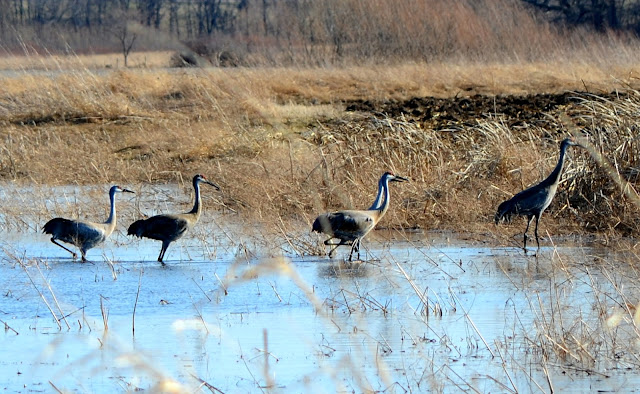When I got to the beginning of the very long line of Sandhill Cranes traversing the landscape. The lead crane had stopped. You may note in the previous procession of cranes that the Canada Geese tended to stop what they were doing and watch the cranes with focus.
Ethologically speaking I'm not sure what the behavior means. What is the relationship between these two species?
A rear crane takes to his wings.
Then two...
Then another.
Three cranes in flight. Note that another pair of geese has come into position on the far side of the cranes.
...further...




The lead crane is now on the far side of the water. The other three who flew forward are now taking the lead across the water.

Remember at the very beginning of the day a male Sandhill had flown over the fence and waited for the female to do the same. Then she took the lead across the grassy area and he followed. That is normally how the forage in pairs. The female leads and the male brings up the rear, I posit, to guard her while she is intent on foraging.
I'll now posit that when something that might be dangerous or even strange occurs in the landscape that a male takes the lead.
See the male on the far right has stopped and is staring intently right.
See? The two cranes that follow are smaller. Females? Yearlings?
If this flock consists of family groups, do the males all switch so that they are heading their family groups?
The group on the land appears to be waiting for something before they enter the water. The geese have formed a line in the water watching the cranes.
Everyone waits a few seconds.
And a few seconds more.
Still waiting.
Some progress on the right and the first left crane enters the water.
Is the fluffed up crane center a juvenile?
Conceivably. Most of the other cranes appear to be hyper vigilant during this water crossing. While everyone else is alert, center crane has lost focus.
Note the absence of the red head patch and the nape of the neck is brown. It is a juvenile.
Sandhill Cranes become sexually mature at two years. Most do not mate until they are five years old but 75 percent of successfully raised young are raised by birds that are 8 years old or older.
One of the reasons hunting extirpated the Sandhill Crane nearly to extinction during the plumed hat era. Too many of the older experienced cranes were killed so besides the death rate many of the younger cranes though sexually mature were not experienced enough to be successful parents.

Here are the lead cranes. A possible family unit?
As the last crane steps into the water, the goose on the right honks to the three geese on the left. Note the last crane off that tussock appears to be a mature male as is the point crane at the front of the nine Sandhills.
And another version of the upside-down-head move so popular with young Red-tailed Hawks.
Amazing. Sandhill Cranes do it too.
The lead crane is still vigilant and a mid positioned crane checks behind.
The last crane stands mid water and watches those before him. The geese are still lined up watching the cranes.
The lead crane starts forward.
They all begin to disappear into the long grass.
And when I move forward the cranes have disappeared. I keep moving forward along the road....private land.
And I keep going.
Long tail, white rump patch. That's a field mark in Peterson's for...what? A Harrier Hawk!
She's so far away and moving at a speed that I have to use autofocus but there is tall grass that keeps grabbing the focus. DRAT!
Wings in dihedral and hunting looking straight down close the ground. Either a female or a juvenile?
Buoyant flight.
Still at long distance but at least coming this way...
And there she is!
TO BE CONTINUED!




































No comments:
Post a Comment